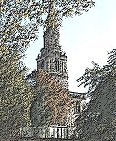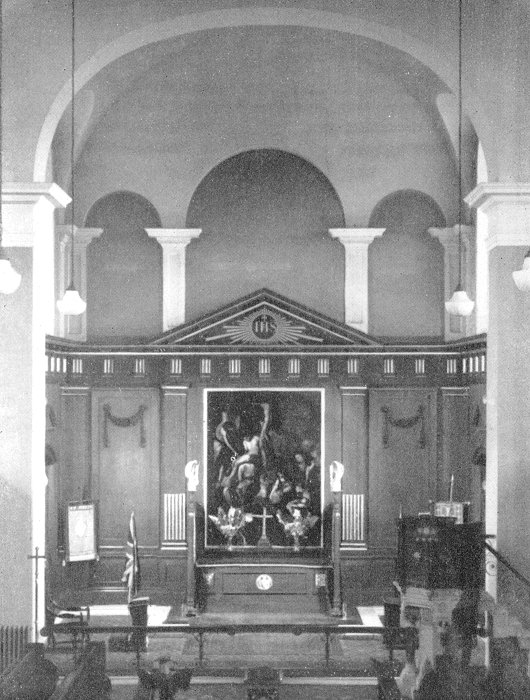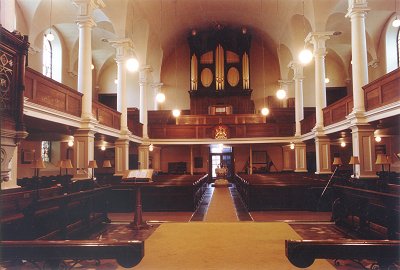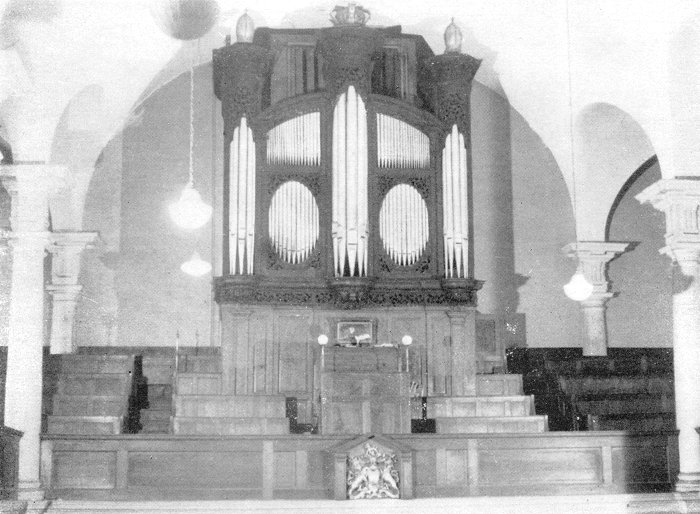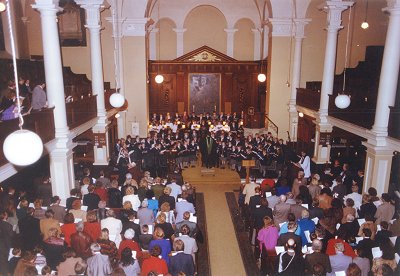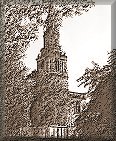The Interior By the great west door, above the notice board, there is an electrotype of the inscription on the bell. This bell is the second oldest artefact in the church and, as the date indicates, was second-hand. It was purchased for £35.1s.8d in August 1766 from George Birch of Birmingham. As work on the spire was still in progress, temporary flooring was placed in the lower part of the tower for its hanging. Cast in 1706, it belonged at one time to St Martin's Parish Church in Birmingham. The inscription refers to an early Rector of St Martin's, William Dagget, and his Churchwardens, Robert Hicks and George Holtham. The font, made of Caen stone with shafts of Devonshire marble, was presented to St John's in 1866 by the Hon and Rev Adelbert Anson, who was a curate here. He later became the first Bishop of the Diocese of Qu'Appelle in Canada, which today is twinned with Lichfield. The font, together with the pulpit and communion rails, formed part of the interior restoration completed in 1869. Prior to that time the church was furnished with box pews, along the top of which at intervals were wooden candlestick holders. After the restoration the church was lit by gas standards. The cast iron bases of these can still be found at intervals on the floors of the pews.
From the centre of the aisle the atmosphere of this place of worship can be appreciated. Light streaming through the clear glass of the upper row of windows gives radiance to the building. Originally there were no brightly coloured stained glass windows and the walls were white washed. Later in 1787 the wardens were authorised to have the inside walls painted "with oil colours of a light colour, also the pillars". On the front of the gallery above the font is a magnificent Royal Arms of George III. These were set up in 1778-9. They were probably carved by William Ellam, who executed the "Commandments", which are of gilded carved wood.
During 1780 a Wolverhampton artist, Joseph Barney, who for 27 years was Drawing Master at the Royal Military Academy, Woolwich, was commissioned to paint "a new altar piece for the East End of the church". This striking picture of Jesus being taken down from the Cross has often been compared with Rubens' painting, of 1812, which hangs over the altar of the arquebusiers of Antwerp in the Cathedral of that City. It is not a copy of this work as had often been stated. The small face in the centre of the picture may well be a self-portrait of the artist. Two sons of Barney became important settlers in Sydney and Brisbane, Australia. The painting was originally flanked by commandment and creed boards, which now hang in the south porch. The Lord's Table, designed in 1929 by J. A. Swan, bears on the front the eagle symbol of St John, the badge of Canterbury and the red and white insignia of Lichfield.
Behind the two carved Flemish chairs the hangings are of material from George VI's coronation in 1937. The imposing eagle lectern was presented to the Church in 1865 but the more accessible and useful lectern in the centre of the Choir dais is preferable for modern style worship. This lectern and a bible were given in memory of James Charles Hastilow, commemorating a well-loved lay reader of the Parish. The north chapel, now used as the Minister's vestry, commemorates Thomas Kilby, a one-time warden and the last Headmaster of St John's School. It is appropriate to mention that the reredos, made from the desk used by Mr Kilby, the Table itself, the communion rails and the credence table now set up in the body of the Church, are all the work of the Rev Joseph Hartill who was vicar 1931-1958. The vestry contains notable portraits and photographs of all the incumbents from the opening of the church in 1760. In the corner of this chapel is the honorary churchwarden's wand of Christopher Wooding who served as Warden for 38 years. This staff was presented on his 70th birthday in 1967. The cushions on the chairs are more Coronation material, this time from Queen Elizabeth's Coronation in 1953.
The south chapel was for a long time used as a choir vestry. However when St Paul's Church, which stood near where the Ring road island is now situated, was demolished, that congregation joined with St John's. The Vicar of St Paul's, Rev W. T. D. Attoe became the new Vicar of St John's following an interregnum of four years. The south chapel was dedicated to St Paul and the cross and candlesticks from St Paul's church installed. On the wall in this chapel is a memorial to one of two men of the Royal Navy from the West Midlands who were awarded the Victoria Cross, For Valour, in World War II. Alfred Edward Sephton served on HMS Coventry and died of wounds received in the Battle of Crete on 18th May, 1941. There are many mural tablets of varying interest, including one of black and white Italian marble that bears the names of 116 men of the Parish who died in the 1914-1918 war. In St Paul's chapel is a memorial to those who died in the 1939-1945 war. Mention must be made of the brass memorial to the Sparrow family on the South wall. The heart of anyone interested in family history cannot fail to be filled with admiration by this list of kindred and affinity.
At the rear of each side-aisle, large doors lead into vast porches with wide stairways to the galleries. These galleries contain their original box pews, which are both uncomfortable and inconvenient, giving those in the side galleries a poor view of proceedings. In the porches themselves are four old boards worthy of inspection. The north porch board was set up in 1768 by the wardens of that time, John Riley and John Sharp, to record the several notable benefactors of the time, including Samuel Whitehouse who in 1761 presented the chalices, patens and flagon, which are of a quality unsurpassed in the county today. Samuel Whitehouse was one of the original trustees of the church. The south porch stairway has a printed subscription list from the restoration of 1869. At the top of the stairs are the commandment and creed boards made in 1778 by William Ellam. These flanked the altar painting until 1899 when the panelling was completed in the sanctuary. |
